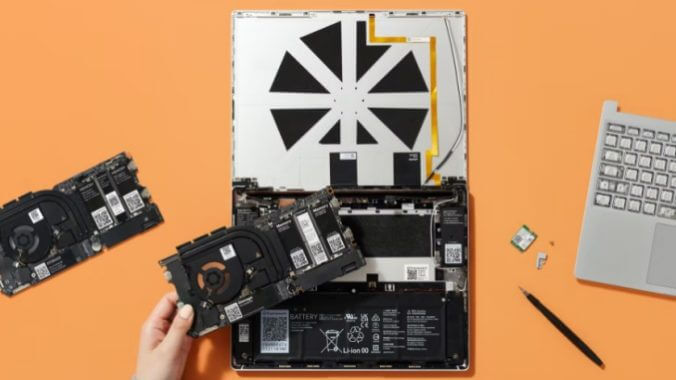Framework’s DIY Laptops Are A Right-To-Repair Refreshment
Images via Framework Tech Features laptops
Framework is the first tech company in quite some time that has earned the right to refer to itself as one of a kind. The company, founded by former Apple software developer Nirav Patel, revolves around the idea of a completely DIY laptop, pushing back against the obsolescence and relentless pace of the tech world as we know it today.
The sustainable system proposed by Framework not only benefits the environment, which bears the weight of over 50 million tons of electronic waste per year, but also the consumer. While issues such as a malfunctioning display or rapidly reducing battery life could be signs of impending doom for a laptop designed for disposability, Framework’s solution to this problem is placed directly in the hands of the user.
The company has strongly aligned itself with the right-to-repair movement, which seeks to allow consumers the ability to repair their devices at home, versus having to bring it to a professional or replace the device completely. Some argue that the right-to-repair movement isn’t possible on a larger scale due to the complexities of technological devices, stating that it just isn’t smart or safe to give users the option of fixing their own products. Many followers of the right-to-repair movement have jumped ship and made their way to Framework after seeing how the company has made a great effort to emphasize that, given the right tools and resources, at-home repairs are no sweat.
Each Framework laptop, made of recycled aluminum and plastic, comes with a small screwdriver that can be used to take apart and replace any part of the computer. Framework users can also utilize the company’s Marketplace feature, which can be easily accessed through their website, providing a storefront where parts can be purchased right down to the mainboard. The Marketplace is accompanied by the website’s extensive selection of how-to guides that help to take the guesswork out of the at-home repairs. The company also recently announced its Framework refurbished program, which diversifies Marketplace options to include used parts and laptops at marked-down prices, making repairs on a tight budget more accessible. Some third-party parts are also supported, in a pinch.
Patel and the rest of the Framework team haven’t sacrificed style for substance, either. The four main notebook models that the company offers have the sleek and portable resemblance of a computer made by Apple or Dell, along with some of the same features. Consumers who are hesitant to make the switch may take comfort in knowing that Framework laptops boast mainstream features such as touch ID and a powerful 1080p webcam. The body of the laptop is thin and light, comparable to a MacBook, but solid and generally sturdy. The company has most recently teamed up with Google to release a model that combines the beloved portability of Chromebook with all the repairability of the classic Framework laptop.
The Chromebook edition of Framework laptops join their two base models – a completely DIY version that users assemble themselves, starting at $819, and a model that comes pre-built, starting at $1,049. Both laptops currently run Windows 11.
As for the future of Framework, the key words seem to be ‘expansion’ and ‘troubleshooting.’ The main consumer complaints regarding the laptop have to do with some of its setbacks that keep it slightly out of the mainstream. For example, battery life on a Framework laptop typically lasts about six hours and takes two hours to fully charge. It’s also not an excellent laptop for gaming, thus cutting Framework off from an entire demographic of consumers.
In terms of expansion, while Framework has expanded its initial laptop and Marketplace releases to be available in nine countries, there are still some restrictions in place. The company’s Framework refurbish program, for example, is only available in the United States, and its new release with Google is only available in the United States and Canada. The path to expansion seems to lie in Framework taking off and gaining recognition, which it is, slowly but surely. With a spot on TIME Magazine’s list of best inventions in 2021 and positive reviews from popular tech YouTubers, the traction gained will surely assist Framework in its mission to provide users worldwide with more sustainable tech, taking some of the strain off of the environment.